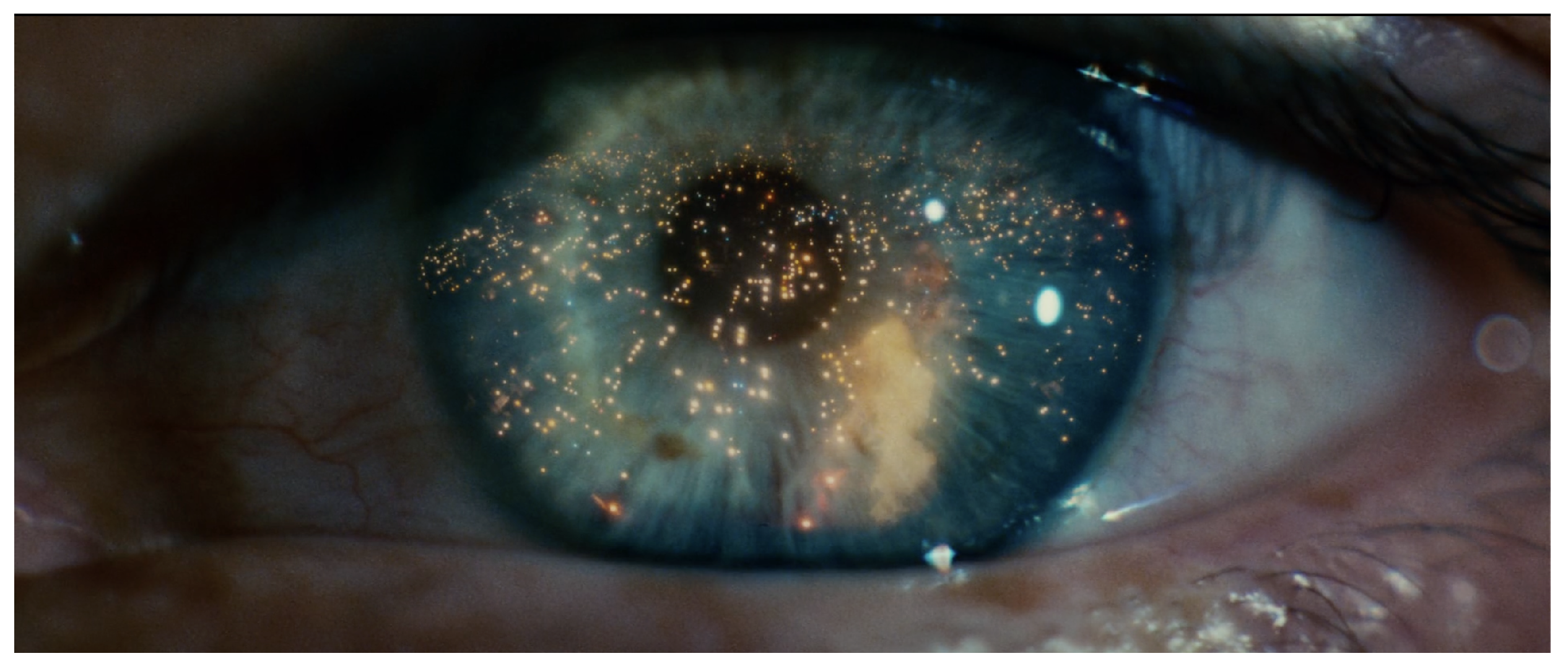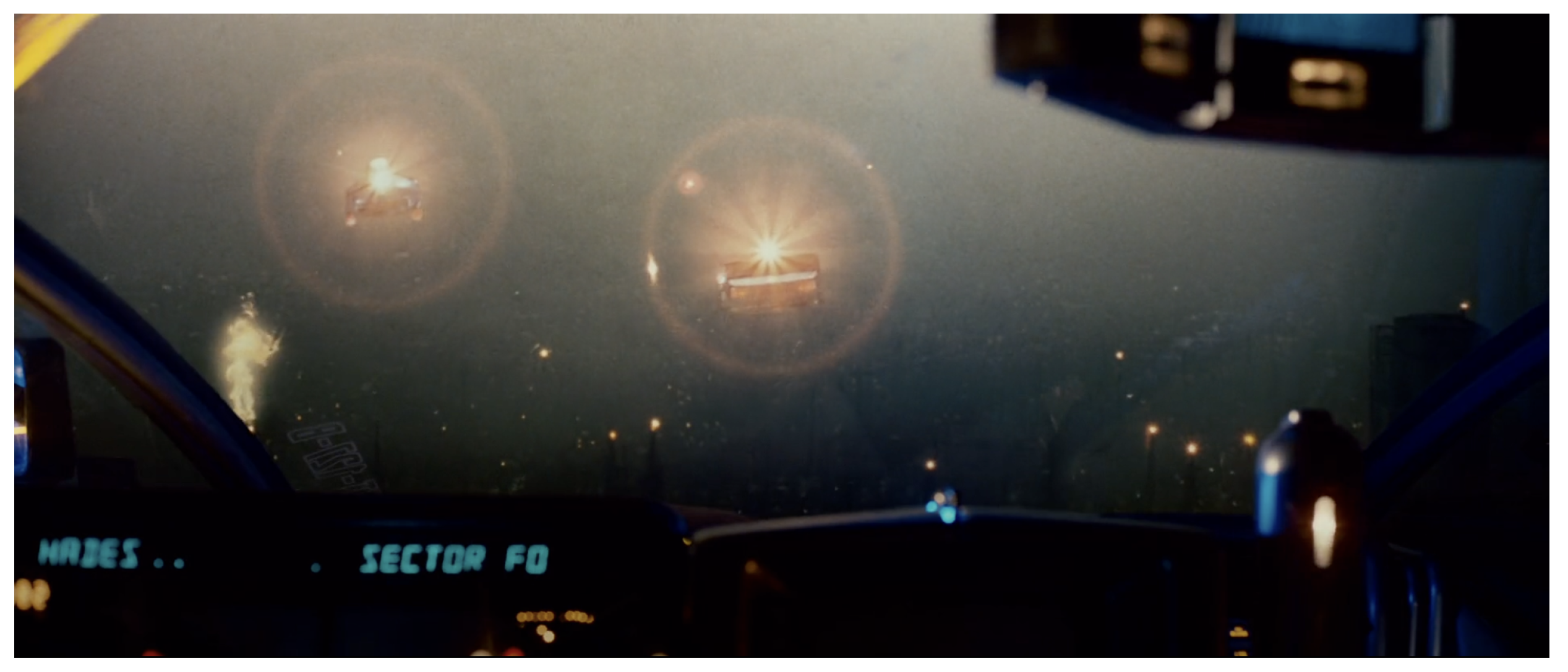Sound and Perception in Ridley Scott’s Blade Runner (1982)
Abstract
1. Introduction
Vangelis had made these beautiful musical textures that were much more like sound design…You never really knew with this sort of grey area: was it sound design? Was it music? It all built towards a very seamless and cohesive soundtrack.
2. A Divided World
The famous main theme for Chariots of Fire is an integral part of the structure of the film as a whole. It functions as a leitmotiv…recurring at several key moments to pull the whole thing together, and where it appears it is often more prominent in the audience’s attention than the visible action. [...] In Blade Runner, by contrast, music serves a much more restrained and traditional function, acting simply as an unobtrusive background to help set the mood of each scene.
2.1. Ambient Soundscapes
2.2. Mixing in Metaphor
While with many films the content of the score could be replaced with no discernible effect…there are a number of scores that would seem to warrant careful interrogation of their thematic relationships.
Whereas classical Hollywood cinema sought to provide sound that was “natural” and “real,” invisible in many ways, contemporary sound design engages the codes of the “real,” yet also presents aesthetic constructions that are at times self-reflexive and overt in their use of techniques of spectacle.
3. Characterizing the Human and Non-Human
3.1. The Spatialized Voice
3.2. The Matter of the Body
4. Sound Is the New Light
4.1. Synaesthesia
4.2. Memory and Repetition
what we saw “happening” did not actually “happen” in our presence…In the shock of the moment that reminds us of our position as spectators, we arrest the fictional continuity of the film’s narrative.
5. Conclusions
Funding
Data Availability Statement
Conflicts of Interest
| 1 | All sounds are mixed to guarantee the intelligibility of dialogue. |
| 2 | Layered sounds are composed and do not translate one single thing (Davies 2012, p. 92). |
| 3 | Rubato is a tempo which marks intervals between notes as a form of interpretation. |
| 4 | These three forms of listening are defined by Chion; codal listening is a semantic mode restricted to language, and seeks intelligibility. Causal listening implies determining what produced a sound within a diegesis. Reduced listening focuses on the traits of a sound independent from its cause or its conventional meaning. (Chion 2019, pp. 25–34). |
| 5 | Notes which are played successively rather than simultaneously. |
| 6 | The note spreads in an uneven way. |
| 7 | The cause of the sound is not fully visible on-screen. |
References
- Altman, Rick. 1980. Moving Lips: Cinema as Ventriloquism. Yale French Studies 60: 67–79. [Google Scholar] [CrossRef]
- Altman, Rick, ed. 1992. The Material Heterogeneity of Recorded Sound. In Sound Theory, Sound Practice. New York: Routledge, pp. 15–31. [Google Scholar]
- Beck, Jay, and Vanessa Theme Ament. 2015. The New Hollywood, 1981–1999. In Sound: Dialogue, Music and Effects. Edited by K. M. Kalinak. New Brunswick: Rutgers University Press, pp. 107–132. [Google Scholar]
- Brinkema, Eugenie. 2011. Critique of Silence. Differences 22: 211–34. [Google Scholar] [CrossRef]
- Chion, Michel. 1999. The Voice in Cinema. New York: Columbia University Press. [Google Scholar]
- Chion, Michel. 2019. Audio-Vision: Sound on Screen, 2nd ed. New York: Columbia University Press. [Google Scholar]
- Chion, Michel, and Ben Brewster. 1991. Quiet Revolution…and Rigid Stagnation. October 58: 68–80. [Google Scholar] [CrossRef]
- Coulthard, Lisa. 2013. Dirty Sound: Haptic Noise in New Extremism. In The Oxford Handbook of Sound and Image in Digital Media. Edited by Carol Vernallis, Amy Herzog and John Richardson. Oxford: Oxford University Press, pp. 115–26. [Google Scholar]
- Csicsery-Ronay, Istvan, Jr. 2011. Review: Sound is the New Light. Science Fiction Studies 38: 501–7. [Google Scholar] [CrossRef]
- Davies, Paul. 2012. Paul Davies talks about Kevin…and Ratcatcher, Hunger, Love is the Devil, The American, Jonny Greenwood and Robert Bresson. The New Soundtrack 2: 83–96. [Google Scholar]
- Doane, Mary Ann. 1980. The Voice in the Cinema: The Articulation of Body and Space. Yale French Studies 60: 33–50. [Google Scholar] [CrossRef]
- Donnelly, Kevin J. 2013. Extending Film Aesthetics: Audio Beyond Visuals. In The Oxford Handbook of New Audiovisual Aesthetics. Edited by Claudia Gorbman, John Richardson and Carol Vernallis. Oxford: Oxford University Press, pp. 357–71. [Google Scholar]
- Kalinak, Kathryn. 1992. Settling the Score: Music and the Classical Hollywood Film. Wisconsin: University of Wisconsin Press. [Google Scholar]
- Lastra, James. 2008. Film and the Wagnerian Aspiration: Thoughts on Sound Design and History of the Senses. In Lowering the Boom: Critical Studies in Film Sound. Chicago: University of Illinois Press, pp. 123–38. [Google Scholar]
- Marder, Elissa. 2012. Blade Runner’s Moving Still. In The Mother in the Age of Mechanical Reproduction. New York: Fordham University Press, pp. 130–48. [Google Scholar]
- McGlynn, James Denis. 2020. Revisiting Vangelis: Sonic Citation and Narration in the Score for Blade Runner 2049. Sonic Scope: New Approaches to Audiovisual Culture. vol. 1, October 6. Available online: https://www.sonicscope.org/pub/iatko5dg/release/4/ (accessed on 27 October 2023).
- Moreland, Alex. 2020. Exclusive Interview—Sound Editor Mark Mangini on Blade Runner 2049, His Creative Process and More. Flickering Myth. March 4. Available online: https://www.flickeringmyth.com/2018/03/exclusive-interview-sound-editor-mark-mangini-blade-runner-2049-creative-process/ (accessed on 27 October 2023).
- Puschak, Evan. 2017. Why Sounds Make up the DNA of Blade Runner. No Film School. Available online: https://nofilmschool.com/2017/05/watch-sounds-blade-runner (accessed on 27 October 2023).
- Rawlings, Terry. 2012. Terry Rawlings in conversation. Signals Channel Two. Available online: https://www.signals.org.uk/film-editor-terry-rawlings-blade-runner/ (accessed on 27 October 2023).
- Rawlings, Terry. 2021. Interview with Terry Rawlings on Blade Runner. The Motion Archive. Available online: https://www.youtube.com/watch?v=31ahdFJnYWY (accessed on 27 October 2023).
- Sigman, Mitchell. 2008. Vintage Sounds—Replicating Replicants: Vangelis’ Classic ‘Blade Runner’ Pads. Keyboard 34: 70. [Google Scholar]
- Silverman, Kaja. 1988. The Acoustic Mirror: The Female Voice in Psychoanalysis and Cinema. Bloomington and Indianapolis: Indiana University Press. [Google Scholar]
- Stiller, Andrew. 1991. The Music in Blade Runner. In Retrofitting Blade Runner: Issues in Ridley Scott’s Blade Runner and Philip K. Dick’s Do Androids Dream of Electric Sheep? Wisconsin: Popular Press, pp. 196–211. [Google Scholar]
- Strank, Willem. 2019. Nostalgie, Futurismus, Fragment: Die Rolle Der Musik in Blade Runner [Nostalgia, Futurism, Fragment: The Role of Music in Blade Runner]. Lied Und Populäre Kultur 64: 201–15. [Google Scholar]
- Ventura, David. 2010. Film Music in Focus, 2nd ed. London: Rhinegold Education. [Google Scholar]
- Whittington, William. 2021. Sound Design and Science Fiction. Berlin: De Gruyter. [Google Scholar]
- Winters, Ben. 2012. Musical Wallpaper? Towards an Appreciation of Non-Narrating Music in Film. Music, Sound and the Moving Image 6: 39–54. [Google Scholar] [CrossRef]






Disclaimer/Publisher’s Note: The statements, opinions and data contained in all publications are solely those of the individual author(s) and contributor(s) and not of MDPI and/or the editor(s). MDPI and/or the editor(s) disclaim responsibility for any injury to people or property resulting from any ideas, methods, instructions or products referred to in the content. |
© 2024 by the author. Licensee MDPI, Basel, Switzerland. This article is an open access article distributed under the terms and conditions of the Creative Commons Attribution (CC BY) license (https://creativecommons.org/licenses/by/4.0/).
Share and Cite
Scotto le Massese, A. Sound and Perception in Ridley Scott’s Blade Runner (1982). Arts 2024, 13, 154. https://doi.org/10.3390/arts13050154
Scotto le Massese A. Sound and Perception in Ridley Scott’s Blade Runner (1982). Arts. 2024; 13(5):154. https://doi.org/10.3390/arts13050154
Chicago/Turabian StyleScotto le Massese, Audrey. 2024. "Sound and Perception in Ridley Scott’s Blade Runner (1982)" Arts 13, no. 5: 154. https://doi.org/10.3390/arts13050154
APA StyleScotto le Massese, A. (2024). Sound and Perception in Ridley Scott’s Blade Runner (1982). Arts, 13(5), 154. https://doi.org/10.3390/arts13050154




